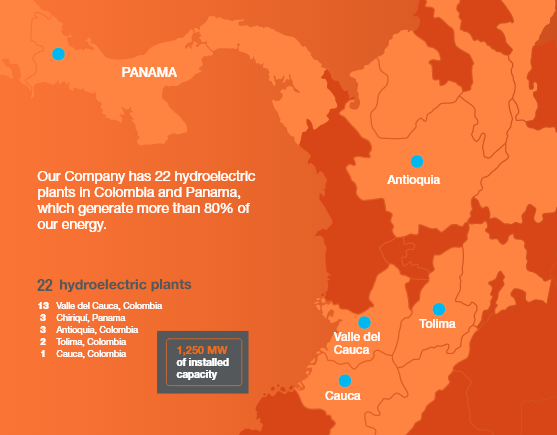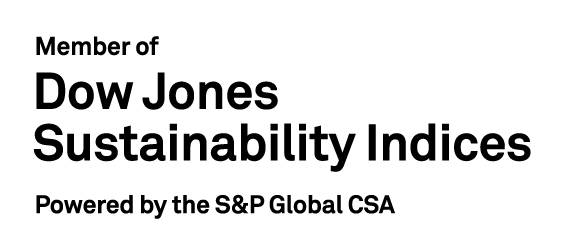At Celsia, we are committed to renewable energy, the conservation of ecosystems and eco-efficiency in processes; our operations are based on the sustainable use of natural resources as a source of clean, safe and reliable energy.
Integrated Report 2020 / We take care of the planet
This chapter covers the topics:
Environmental management
Energy resource management
Climate
change
Eco-efficiency
Biodiversity
At Celsia, we drive the transformation of the Organization; we have a combination of processes that allow us to reduce environmental impacts and increase efficiency to achieve both environmental, as well as economic and operational improvements. These actions are implemented with excellence and leadership in favor of the environmental conditions of the environment where we develop our projects, in the operation of assets and in due diligence throughout the value chain, taking into account the expectations of our Stakeholders and the timely management of risks.
We focus on looking for opportunities that allow us to be more environmentally responsible and more profitable over time. For this reason, we have the best practices for the efficient use of water and energy, the integral management of waste, the management of discharges and the control of atmospheric emissions, thus allowing business continuity.
During 2020, we managed to certify power generation under the ISO 14001:2015 Standard, the verification coverage percentage of which is 96%.
We also have different third-party verification schemes, which include internal-audit actions carried out by an external consulting firm.
The National Environmental Licensing Authority (ANLA, in Spanish) granted us a license for the construction of the El Tesorito Thermal Power Plant, with a capacity of 400 MW, in the municipality of Sahagún, the Department of Córdoba, Colombia.
All the information of the Environmental Impact Studies (EIS) of the plants in operation and of the company’s projects is public and is filed in the offices of the competent environmental authorities, where we are present.
On the other hand, energy-resource management plays an important role for business continuity, given that we have thermal-generation assets to support our operations.

For this reason, we promote projects to optimize generation to conserve and preserve water in the territories where we are present, in order to ensure the availability of this resource and generate energy with alternative sources, such as the sun and wind, the use of which reduces the pressure on non-renewable natural resources, always aligned with the policies and strategies established by the Organization.
At Celsia, we project an increasingly clean and balanced energy matrix, with a high share of non-conventional renewable energies, considering the development of innovative, low-carbon products and services, supporting the reduction of the impacts associated with greenhouse gas (GHG) emissions and optimizing the availability of natural resources, which are a priority for our Organization.
We define the management of atmospheric emissions with the help of the measurement of the carbon footprint; in addition, we implement action plans in order to focus on opportunities for improvement in our processes through our controls. And, thus, we guarantee environmental legal compliance, framed in the emission of significant fixed sources identified in the Organization. Some of the aspects of 2020 in terms of climate change that we highlight are these:
With respect to the integral management of solid waste within the Organization, for 2020 we highlight:
On the other hand, many of the ecosystems in which we have assets and projects in Colombia and Central America are highly biodiverse and sensitive to interventions. For this reason, at Celsia we are committed to protecting biodiversity from the early stages of management in our projects and assets under construction and operation.
Our goal is that by the year 2025 all new projects and all facilities currently in operation will have an early assessment of risks on biodiversity or a biotic management plan, so that we avoid the net loss of biodiversity and – where possible – let us have a net profit from it.
During 2020, with the ReverdeC program we contributed to the ecological restoration of more than nine basins in Colombia.
We planted
new trees
We achieved a consolidated
figure of more than
new trees
in the country
How did we respond to COVID-19?
During 2020, we encountered several challenges: one of them was the change in the mode of operations, which forced most of the employees to work remotely and to possible changes in the execution of scheduled maintenance, which caused a decrease in waste indicators, other emissions, energy consumption, etc.
Consequently, we had a 91% decrease in the waste generated during the 2020 operation, a 61% decrease in energy consumption from non-renewable sources and an 86% decrease in water consumption.




For a better experience on our Website, we recommend using the
Chrome or higher, Firefox or higher or Mozilla or higher browsers.
_________________________________
Copyright © 2021 Grupo Celsia. All rights reserved. Medellín, Colombia.
Design, journalistic editing, Development and assembly: Taller de Edición.